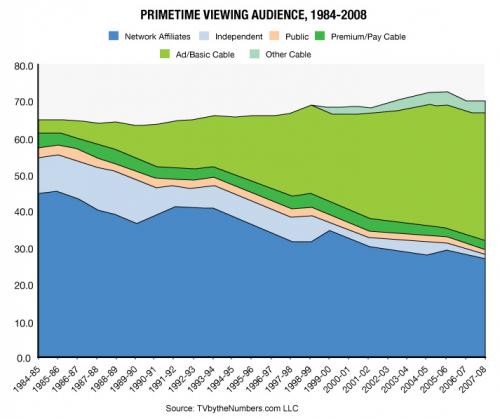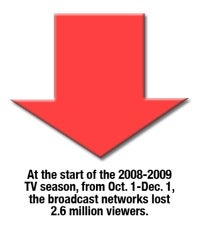The broadcast networks enter the annual upfront buying season in dire straits.
When the networks pitch their wares to ad buyers starting May 18, they will be trying to sell the sizzle of an industry moving backwards.
According to research conducted by cable conglomerate Turner Networks late last year, the broadcast nets lost 2.6 million viewers in the first two months of the 2008-09 season, 2.2 million of which were in the key 18-49 demo. There is no precedent for that kind of decline.
At that time, only 12 percent of returning network shows were up versus a year ago in ratings, and only two new series had managed to improve upon their time periods.
Add to this, of course, what is perhaps the softest advertising market in a generation. By the time the ongoing second quarter is finished, advertisers are expected to have canceled about 12 percent of the TV advertising they committed to during last year’s upfront.
No wonder, then, that while presenting NBC’s new pilots to advertisers this week at the network’s “infront” — an early peek at the NBC shows that was held Monday — network co-chair Ben Silverman pledged a “deeper engagement” with sponsors, declaring the moment to be “the early morning hours of the first day of the next 50 years of our relationship together.”
While the big broadcast networks always liked having Madison Avenue around during the previous half century, they’ve stepped up their courtship of late with an increased focus on the always-tricky business of brand integration.
“It’s a much more collaborative process now,” said Mike Pilot, president of sales and marketing for NBC Universal. “Our conversations are going deeper than every before.”

And during this spring’s upfront TV ad-selling season — a distinctly buyer’s market that could, according to Barclay’s Capital, be down as much as 15 percent from last year, or about $1.3 billion all told — that collaboration is getting ramped up to a whole new level.
So for the networks and the buyers, it’s a lot different than last year, when the market was actually up 5 percent to around $8.8 billion, despite the fact that negotiations with advertisers occurred during big audience declines — and, of course, the recession.
Under Silverman, an executive who seems to be as well liked among advertisers as he is derided in many Hollywood creative circles, NBC continued on Monday to emphasize themes of advertiser friendliness and “partnership,” proudly showing how brands including Honda, Subway and Turbo Tax have been written into the plots of series ranging from “30 Rock” to “Heroes” this past season.
In fact, while himself presenting Jay Leno‘s new 10 p.m. talk/variety show, Silverman grew emphatic when he noted, “Most importantly, Jay is one of the most advertiser-friendly personalities around.”
Getting ready to unfurl their own upfront presentations in the coming weeks, rivals ABC, CBS and Fox will undoubtedly make enthusiastic product integration a bigger selling point this year, too. (See accompanying story on what the networks have in store at this year’s upfronts.)
 “In almost every development meeting we’ve had with the networks recently, people are taking a page out of Ben’s playbook — they seem to be educating their producers on how to work with brands in a different way,” said Laura Caraccioli-Davis, executive VP and entertainment director for media agency Starcom USA.
“In almost every development meeting we’ve had with the networks recently, people are taking a page out of Ben’s playbook — they seem to be educating their producers on how to work with brands in a different way,” said Laura Caraccioli-Davis, executive VP and entertainment director for media agency Starcom USA.
“It all started when they hired Ben — they knew it was his background,” she added. “Some of us have always pushed for more (product integration). But now, the doors are really opening up.”
For producers and showrunners, this stepped-up advertiser embrace on behalf of the network execs they’re beholden to means they’ll likely be working more closely with brand representatives than ever before.
“A lot of people want to do integrations the way Mark Burnett used to do them on ‘Survivor,’ Caracciolli-Davis said.” ‘Give me your product, and you’ll see it when everybody else does.’ But things have changed. Network executives are now having conversations on the head end with producers to makes sure they understand the dynamics in play.”
While an increased focus on product integration during this year’s upfront selling period will likely lead to interesting dynamics within the production community during the coming season, it’s unclear as to how it’ll actually help the bottom line for the networks this spring … or how low that bottom line might actually end up being.
Arriving in New York amid a severe recession, and having cumulatively lost an audience size equivalent to the population of Philadelphia this past season, the networks certainly seem to need any negotiating traction they can get.
But on both the buying and selling side, few seem to buy into the notion that the market will be down as much as the 15 percent Barclays predicts.
“National television hasn’t suffered as much as other media, and during tough times, advertisers tend to turn to what does the heavy lifting, and that’s broadcast television,” added Andy Donchin, executive VP and chief investment officer for ad-buying firm Carat. “And I for one am still very bullish on broadcast television.”










